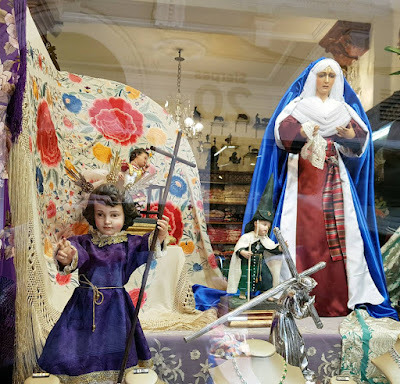Carmona, less than 30 minutes drive from Seville, is a beautiful, historic, small town. It is the Spanish home of Michael Portillo, the TV rail traveller and ex-MP. His connection with Spain is a father who lectured at Salamanca university and fled to England at the time of the Spanish civil war. Disappointingly, Michael did not put in an appearance to show us round.
We parked outside the old town in an underground pay car park. Although there are several free parks, these are patrolled by self appointed parking attendants wearing official-looking high-viz jackets who demand money for parking, so you either pay up or risk damage to your vehicle. We’ve come across this at other places in Spain.
Emerging from the car park, we see a lovely view of San
Pedro church with its tower modelled on the Giralda tower in Seville.
It’s a double gate, and the next photo shows how massive and
well fortified it was. Nothing, of course, is completely original as is see
from the Moorish arches added later.
Just inside the gate, the old town is pleasantly laid out mainly
in this style of building.
It’s a short walk to the central square, the Plaza de San
Fernando. Folks from my generation will understand when I say that the last
train is still expected here. The square contains some splendid Moorish style
buildings like the Casa de Cabildo, the
old town hall.
Just beyond the square is the 14th century church
of Santa Maria la Mayor built over a mosque. The tower is thought to be adapted
from the mosque’s minaret.
Inside, the church is beautifully proportioned, with marble
tiled floors and sweeping arches.
Leaving the church, we walked to the Cordoba Gate at the
other end of the old town, from where the road sped on to Cordoba. It’s a fine
old edifice, originally Roman but modified many times since. The latest
modification appears to be stopping it from crumbling.
Onwards and upwards to Pedro’s Alcazar, a massive fortress
that dominates the eastern side of the town. The fortress walls were badly
damaged by an earthquake in 1504, but apparently never fully repaired.
Part of the decaying structure was saved by being
converting into a parador. These are state-run hotels usually in ancient
buildings that would otherwise have been lost to the ravages of time. So, we go through this gate…
…and into the parador grounds.
Paradors operate at the higher end of the hotel market, but perhaps not luxury category. This one costs around £200 per night for a double room - well over a week’s campsite fees!
One reputed gem we didn’t have time to visit was the Roman
necropolis, half a mile out of town. We’ll look forward to seeing it another
time, and the town merits another visit.





















































